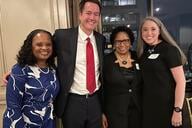You have /5 articles left.
Sign up for a free account or log in.
Colleges and universities are facing increased scrutiny over how accessible their websites are for individuals with disabilities. In fact, last year alone, the U.S. Department of Education’s Office of Civil Rights (OCR) received nearly 250 complaints about the inaccessibility of post-secondary institution websites.
Closer review and inspection by regulatory agencies, coupled with the desire to appeal to and reach more potential students and donors, has made improving online accessibility an increasingly important issue for higher education marketers.
By now, most higher education marketers are familiar with WCAG 2.0 guidelines and the need to adhere to the principles outlined in order to have an accessible website. But, how do you go from awareness of the guidelines to actually improving the accessibility of your institution’s .edu site?
Here are five practical steps you can take to make progress now:
- Invest in a web accessibility checker. The first step in making progress is to identify the problem areas on your website. A web accessibility checker, like SiteImprove or WAVE, will crawl your institution’s site and identify areas of non-compliance. A good accessibility checker will define and prioritize which issues are most critical to address. For example, through our site checker, we quickly discovered we could significantly improve accessibility by making a simple change to the color of hyperlinks, a change that ensures the color of our links and the website’s background color meet color contrast ratio standards.
- Set aside time each day to make small improvements. Once you have a handle on the most critical issues to address, make sure web team members spend at least 15-30 minutes each day making improvements. This may mean having a writer carve out time each day to add alt-tags to images, or having a web developer research the best way to correct color-contrast problems in the site wide navigation. Dedicating a small amount of time each day is a manageable way to steadily address the issues uncovered.
- Partner with other offices on campus to solve the issues you uncover. Nearly every college campus has individuals and offices with accessibility expertise. Find those experts and advocates on your campus and enlist their help. At Meredith College, in addition to disability services staff, we found experts on the library staff who helped brainstorm and investigate creative solutions for making online documents accessible. Members of our technology services team shared their knowledge about accessibility resources as well.
- Establish a process for making items accessible before posting. One of the most important steps you can take to improve accessibility is to prevent inaccessible information from ever getting on your website. If your institution is like most, PDFs, photos, and videos are relied on heavily to convey important information on the website. If these assets are not developed or posted correctly, all can present accessibility challenges. Develop a process to ensure videos are closed-captioned and have descriptive audio before being loaded to your site. Similarly, make sure documents are checked for accessibility before being converted to PDFs and posted publicly.
- Invite users with disabilities to verify improvements. Once some improvements have been made to your site, invite users with motor, visual, hearing and other impairments to test the improvements. While automated systems are tremendously helpful in identifying and addressing problem areas, there is no substitute for testing pages and accessibility fixes with real humans, who will encounter things that automated accessibility checkers missed. Your disability services office can recommend students or recent graduates who may be willing to participate in usability testing.
There will be many benefits to taking these small, proactive steps to improve the accessibility of your institution’s website. Not only are you doing what’s morally and ethically right, you will be helping your institution reach more constituents and potentially save your institution from the time-consuming, costly and stressful process of an OCR investigation.
It’s important to view these changes as improvements we want to make in order to better meet the needs of all individuals, rather than extra work just to be compliant.
Kristi Eaves-McLennan is vice president for marketing and communications at Meredith College, in Raleigh, N.C.




